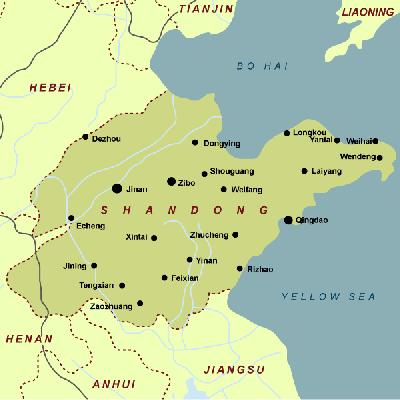| Map |
|
|
Shandong
Shandong has a warm-temperate monsoonal climate, with hot, rainy summers and dry, sunny winters. It has a mean annual temperature of 10.5oC-13.5oC -- the hottest month, July, averaging 24-27oC and the coldest month, January, -4-1oC -- and a mean annual precipitation of 550-950 mm.
It is divided into 17 prefecture-level cities, 31 county-level cities and 61 counties, with a population of 90.79 million by 2000.
Lu Cuisine (Shandong Cuisine) is one of the Eight Great Cuisines in China.
L¨¹ Opera, Shandong Kuaishu (singing and reciting, an art genre of Chinese Quyi)
Renowned traditional local products include clocks and watches of Yantai, porcelain of Zibo, kites of Weifang, shell carving and beer of Qingdao.
Shandong Province is called Lu for short. Shandong is a key production area of grain, cotton and oil crops. It usually ranks first or second in production output. Shandong is also well known for its tobacco, fruit, peanuts, tussah silks, meat, and marine products. Its major mineral deposits include coal, petroleum, iron, aluminium, and gold. The coastal area is abundant in fish and salt. Shandong's industry covers oil extraction, processing, machinery, electric power, chemicals, foodstuff, textile, arts and crafts, and papermaking, etc.
With railway as its mainstay of transport, Shandong is one of the provinces with the most dense highway network. It has seaports like Qingdao, Yantai, Weihai, and Rizhao, etc. Major cities are Jinan, Qufu, Qingdao, Yantai, Weifang, and Zibo.
Shandong is rich in historical and cultural resources, and gifted with beautiful landscapes, with 157 cultural relics preservation sites under the state protection. Among its famous scenic spots and historical sides are Taishan Mountain, Laoshan Mountain, the Lingyan Temple, seaside of Jiaodong Peninsular, Confucius Family Mansion, Confucius Woods and Temple in Qufu, etc. Qufu and Jinan cities are famous historical and cultural cities in the world. Jinan, capital of Shandong Province, is known as the City of Springs with the famous Daming Lake and at least 72 famous springs. |
||||
 |
 Geography
Geography